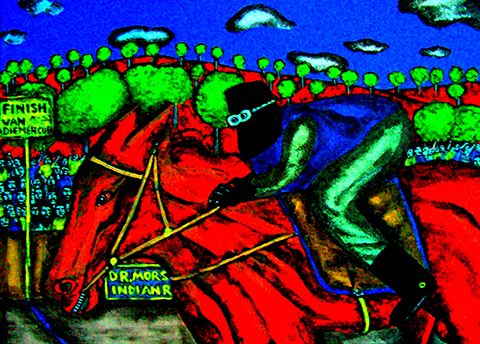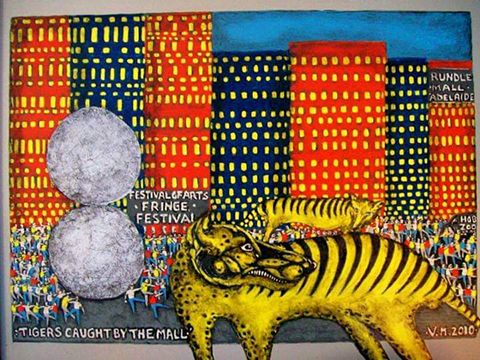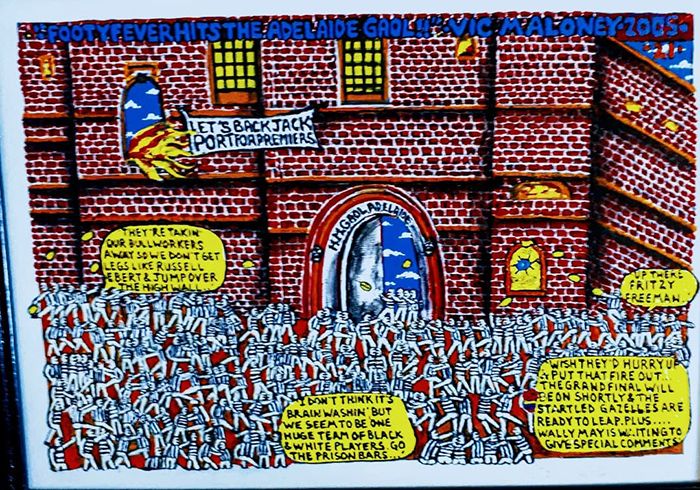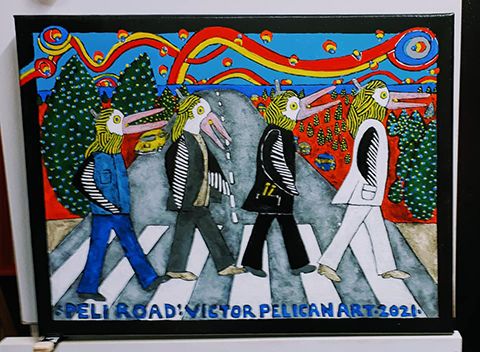Life is Art and Art is Life with Victor Maloney: Part Five
I want to dive a little deeper into the style of painting being used by Victor Maloney whose paintings and narrative we have been enjoying over the past couple of weeks. If you missed the previous four posts please check them out before reading this post. They are:
Life is Art and Art is Life with Victor Maloney: Part One
Life is Art and Art is Life with Victor Maloney: Part Two
Life is Art and Art is Life with Victor Maloney: Part Three
Life is Art and Art is Life with Victor Maloney: Part Four
Victor Maloney' style sits within the Naive Art school of painting but with a difference: it is not simple and certainly not unsophisticated. There is no childlike simplicity of execution and vision as seen in many naive works.
These paintings are finely executed by a master of composition, shape and colour who admits that he does take his painting ventures seriously whilst trying not to take himself too seriously! 1
Victor does closely align with the Naive School in his use of narrative to form the composition of the work. Each painting is like a chapter in a book and many form part of a series as Victor likes to explore various themes - both historically and visually - often marrying the two. We saw many examples of Maloney Narratives in previous posts on his works.
Today I want to look again at a painting we saw a couple of days ago...

This has to be my favourite Victor Maloney painting and not because I love horses and will admit to the occasional flutter on the races.
Victor's use of bold primary colours is very much in line with naive painting. Traditionally the primary colours are Red, Blue and Yellow (which in this painting is only used to touch the reins). But this definitionn of primary colours is based on mixing paints and not on the way we see light. The Red, Blue and Yellow primary colours are called Subtractive Primaries 2. But what Victor has used in this painting - Red, Blue and Green - are called Additive Primaries, discovered by Isaac Newton as being the basic ingredients needed to create clear, white light.2 Red, Blue and Green when combined make more light!. And you can see the effect in this painting. If you would like to learn more about this fascinating topic please click here.
Apart from the palette used in this painting there is the very clever composition which sees the foreground and figure of the horse melting through the middleground to the background. The symbolism of this camouflaging is very important to the narrative as Ned was not only a notorious bushranger sought constantly by the police, his presence in Tasmania (as being teased out by Victor) was a secret mission!
The other feature in Victor's paintings which characterises naive painting (also sometimes called Modern Primitive) is the use of repetition of shape to form patterns. We see this feature very much in the works of the Australian Outback naive artist Hugh Schulz which Andrew from the Hunter Valley Region of New South Wales collects.
In Victor's Ned Kelly wins the Hobart Cup, the trees and clouds form the repetitive pattern and in behind the Finish Line sign you can see the repetition of the faces of the spectactors.
Victor, like many naive artists, does like to imbed some humour into his images and this is done, apart from the farcical winning of the race by Ned, in the sign attached to the horse's bridle. I think I will leave you all to work this one out and I have given you a Comments Box to argue what the meaning of this sign might be.
Repetition of pattern is taken to effective extreme by Victor in the execution of his buildings. And again you also can see the repetition of the pattern of human figures. And with delight we can announce that some of the thylacines did manage to escape from Tasmania and make their way to the world famous Adelaide Fringe Festival of Arts!

Victor tells us that:
My art has been described as modern primitive and I like to project some humour in my paintings as well. I only use acrylic paint on canvas or MDF board and have developed what I call Organic 3-D Art.
We will have to get Victor to explain in a little more depth what he means by Organic 3-D Art but for me as a viewer it means that he is expressing ideas about living matter in such a way as to create the feeling that you can walk around the shapes in the paintings and appreciate the width, depth and height of their visual and narrative content.
Often part of the Living content in a Maloney painting are words being used to help express the narrative and emotions taking place on the visual board and thus adding to the organic flavour. We saw miners in the Maloney Outback Australian paintings and below in Footy Fever Hits the Adelaide Gaol prisoners in an Adelaide gaol express their frustrations. The printed word is an essential part of the paintings of Victor Maloney.

And endorsing the organic flavour of the paintings are many anthropomorphised animals such as the thylacines you have already seen and tomorrow you will see more of Victor's pelican art. But as a teaser here is Peli Road with that Maloney signature link to historic and social events.

So.... who or what is the master in a Victor Maloney painting? Is it colour which leaps out at you almost aggressively? Is it shape married to the repetition of patterns? Or is it the narrative enhanced by the numerous patches and paths of print which entice the viewer to wander along and think down into the dimensions of the image?
It is all of these elements which Victor successfully melds into startling and inspirational works though he has told me that he beleives that a painting is basically composed of realms of colour and controlled by colour and that the rest of the work just falls in...1 Certainly something to think about for those of us who like to wield a brush covered in paint!
Enjoy the video below where you will see more of Victor's paintings and tomorrow - a delightful post to conclude this series where we frollick with pelicans!
© Thank you to Victor Maloney who kindly gave permission for the images of his work to be shared on AnArt4Life.
You can follow Victor on facebook by Clicking Here and on Instagram by Clicking Here.
Victor is also a passionate writer with examples of his 3-D writing works available on his maloneyvictor Instagram account.
Credit
1. Correspondence from Victor Maloney
2. science.howstuffworks.com/primary-colors.htm
